
One cold evening, this past November I was taking a break from writing; surfing around the web, from E-Bay to Kijiji through Craig’s List and the like. I stumbled over an add that simply read ‘Old Tools’. I clicked on the add and viewed the pictures; nothing out of the ordinary, a few old hand saws, a couple of wooden planes and then the usual bottom of the tool box items such as auger bits, broken hammers a screwdriver or two…
I noticed as well in the photo a decent looking wooden bodied plough plane and decided to e-mail the seller for a quote. $100. bucks for the lot. Perfect. I made the deal and received the box of antiques. They’ve been sitting in my shop now for a few months and last night I decided to go through the items and have a closer look. Turns out the two wooden bodied planes, a Jointer and this Jack are pretty nice. They’ve both seen some use and have the normal wear and tear, a few decades of grime and decay but both seemed to have been well kept by their previous owners. I took the Jack plane out and disassembled the parts. I gave the entire surface a good going over with some mineral spirits and then this morning I started to re-tune it. The following are the steps I took to resurrect this old Jack plane.
Beginning at the soul, where everything should begin, I took some 100 grit 3X Norton sandpaper and with some double sided tape applied it down to a sheet of safety glass I have for sharpening. I checked the bottom before hitting the abrasive with my winding sticks to see if I could detect any noticeable humps or valleys. Some dark pencil lines scribbled across the bottom will help to keep track of my progress. I’d say no more than 10 minutes on the 100 grit and things were getting pretty smooth. From there I moved along to some 220 grit and repeated the process, again making some pencil marks and carefully monitoring my work. A few more minutes and I was done. I repeated these same steps with the wedge until it too was in the ‘house of pancake range’.
With the soul of the plane addressed and the wedge ready to work I moved onto the chip breaker and iron. If and when you watch my new DVD, (hopefully this coming Christmas when Santa stuffs it in your work sock) you’ll see me explaining some of the advantages and disadvantages in Flea Market tools. I mention that if you do decide to fix up an old tool that I don’t recommend reusing the iron. Instead I usually opt to replace it with a thicker, modern variety. I should say that this philosophy usually rings true, especially with old Stanley planes that originally came with thin irons that are prone to chatter. This plane however had a nice thick iron that seemed like it had lots of life left in it. With that I went to work on flattening the back. Beginning with an aggressive 220 grit Norton water stone I started the ‘ol pushin’ and pullin’ routine. About two solid hours in I had to ask my wife to give my back a rub…serious muscle aches. I was thinking to myself that I should have listened to my own advice but with the couple of hours already invested, I had to continue on. Moving on up from 220 to 1000 to 4000 and finally 8000 the iron was finally there.
Flat…just like the tender spots on my thumbs from pressing down onto and into the antique tool steel. I turned the piece over and checked it across the width for square; not too bad but needed some work. I re-established a straight, square edge on my slow speed wet-grinder, (the only powered tool in my workshop I might add) and then onto re-establishing the bevel. 25 degrees and back to the stones. 1000, 4000 and finally 8000 to finish adding a secondary micro-bevel to the leading edge. Back over to hone and cut off the burr I finish with the ‘ruler trick’ and call the iron done. I cleaned and dressed the chip breaker as well, actually using my water stones to flatten the leading edge. Some more sand paper on glass to clean up the years of rust and a nice light coat of machine oil for both. You’d be surprised at how quickly rust will develop on old tool steel like these. Seems even more so once you’ve cleaned off the grime that was probably preserving them in some strange way. A nice thing now, which always happens at some point in the refinishing of old tools is the story starts to emerge. Up until this point I really had no idea of where this plane had come from. There were no visible marks or emblems anywhere until the dark dirt was removed from the top of the iron. Ohio Tool Co. Ahhh, good to meet you sir. I Googled the company name and found very little information; the company it seems didn’t last all too long but here is a little history for the Galoots in the room.
 1823-The Ohio Tool Company started operations in Columbus, Ohio.
1823-The Ohio Tool Company started operations in Columbus, Ohio.
1841 to 1880-The firm made use of Prison Contract Labor from the nearby Ohio State Penitentiary.
1851-The company was incorporated with a capital stock of $190,000. It employed about 200 and was frequently called “The Plane Factory” since carpenters’ planes were the chief article of manufacture.
1858-The Ohio Tool Co. officers this year were George Gere, President; A. Thomas, Secretary and Treasurer; and C. H. Clark, Superintendent.
1865-Patents issued in this year for mortising machines used in cutting plane stocks helped to speed production.
1887-The Ohio Tool Co. employed 70 hands.
1893-The Auburn Tool Co. and the Ohio Tool Co. merged with offices in New York and factories in Auburn, N.Y. and Columbus, Ohio.
1900-The Ohio Tool Co. received the highest award given on carpenter’s tools at the Paris Exposition.
1903-The Business Directory of Columbus lists the company at 63 North Scioto Street which was close to the Scioto River. “Scioto” was marked on their second grade planes.
1914-The Company moved to a new plant at Charleston, West Virginia.
1920-The Ohio Tool Company ceased operations.
With the chip breaker and iron ready to go to work I turned my attention to the throat and mouth of the plane. A little file work to re-establish the edges of the mouth and then into my tail vise to clean out the throat.I test fitted the newly sharpened iron assembly and was happy with the fit. I then gave the entire body of the plane a nice heavy bath of boiled linseed oil. Ahhh….goes down good. The age of the tool and the dryness of the wood soaked up the oil in no time at all. From there it was now late afternoon and finally time to take it for a test drive. A few small knocks with one of the hammers that came in the box of tools and voila! A nice paper thin shaving rolled up and out of the throat. Like a boxer past his prime getting a second chance at the belt; a title shot. This was a good day for the Ohio Tool Company and a good day for me. It wasn’t about how much the plane cost or how long it took me to get it back in working order; it was simply a day spent in discovering a small piece of some history all but forgotten…
The overall dimensions of the plane are 16″ long x 2 7/8″ wide. The iron is 2 1/4″ wide and slightly better than 3/16″ in thickness. I mentioned the nice old Jointer and wooden bodied plough plane; they’ll no doubt get this same treatment sometime in the future when my back stops aching and my thumbs return to their normal shapes!

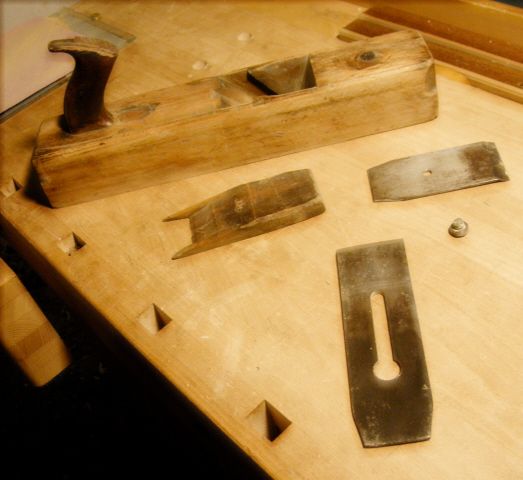

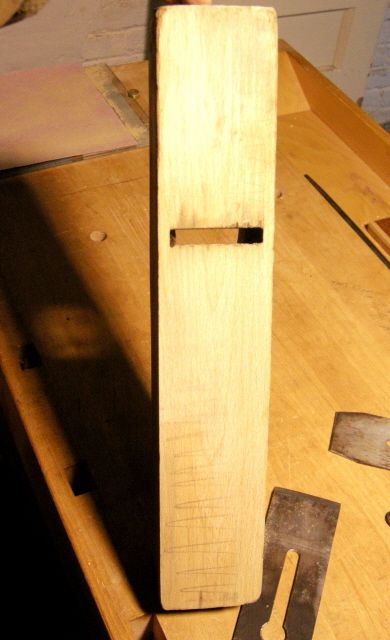

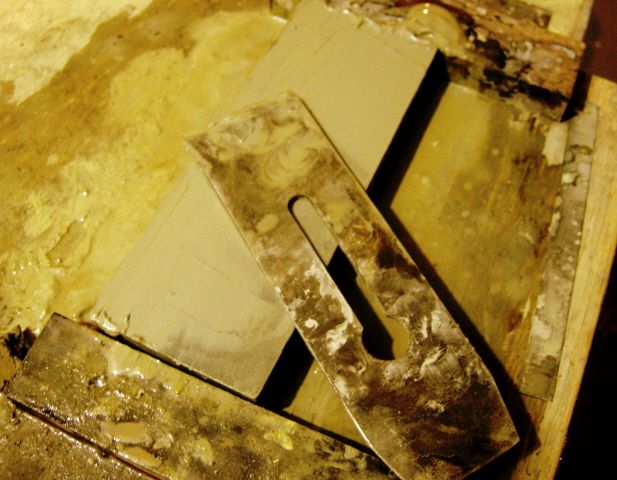
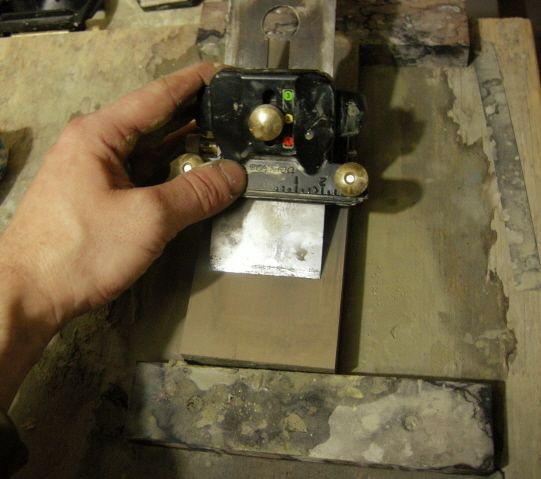

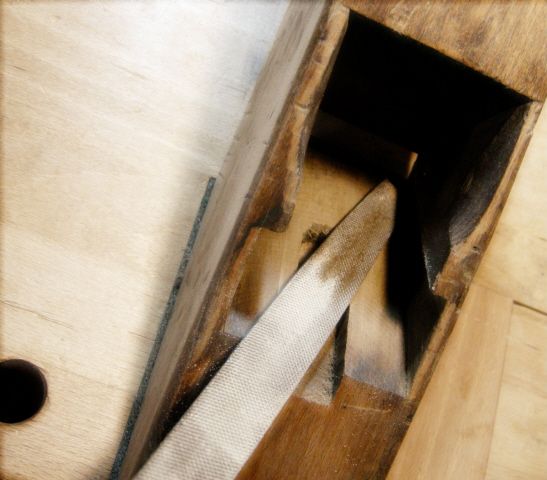
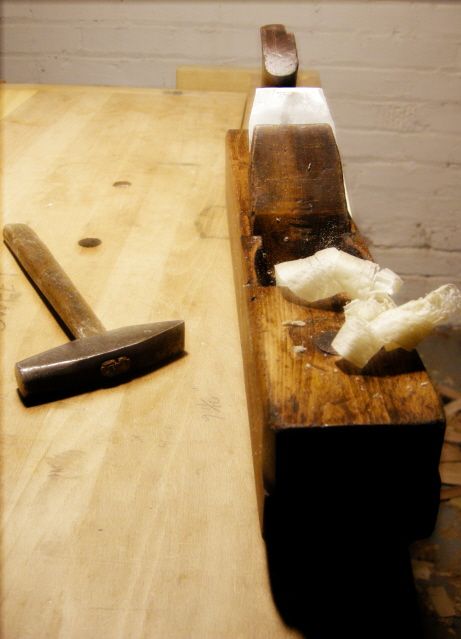
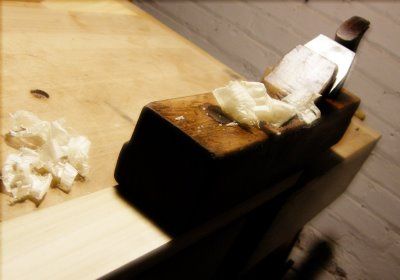






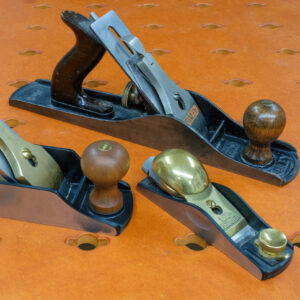












Comments
Interesting to see this article on tuning a jack plane, albeit a wooden one, after watching Andy Rae's bridle joint video.
Not finding any other appropriate place to make a comment -
I was always taught to set a plane down on it's side, except for my rebate plane which I put down upside down with the blade up. Andy violates both those "rules."
I can identify with the tuning of the old plane, but it is so incredibly gratifying, and they work beautifully. A little tender loving care.
Tom,
I have not been as thorough or professional as you with the Ohio planes I have purchased at antique shops over the course of years. And I spent a LOT more than 3 hours on reconditioning the plane bottom, old iron, and chipbreaker (I think it was at least 12 hours). The resuscitation took that long because the bottom had cracks and dings, and the iron had some pretty serious rust issues, too. The chipbreaker seemed like it had "flattened out" more than usability seemed to dictate to my untrained eye, and, well, the whole thing just needed some serious TLC. I think I spent $55 on my first Ohio, and after those many hours taken over the course of a few days, I like how it handles. I like its feel. I enjoy what it does for me.
So I have since found a second Ohio plane that needs some TLC. To start with, it needs a new "saw handle". Can you suggest a place to find a replacement? Or should I just plan to fashion my own?
Fred,
Besides rumaging through 'ol flea markets and antique dealers I wouldn't really know where to start looking for a replacement tote. (handle)
I'd suggest you make your own, it could be a fun and rewarding experience for you as well as giving the tool a 'custom 'made by Fred original'.
Cheers!
Hi Leescabinets1,
I'll forward your comment to Andy Rae.
Christian Becksvoort responded to a similar Letter to the Editor in the magazine a couple years ago. Read more on How to lay down a plane here:
http://www.taunton.com/finewoodworking/Community/LettersDetail.aspx?id=26915
Sorry to hijack your discussion Tom!
Gina, FineWoodworking.com
Hey, leecabinets1!
It's astute of you to notice how I and other woodworkers handle their planes. Although I've had no formal training, I've had the good luck to have many woodworking mentors in my time. The man that taught me to lay a plane on its side—regardless of the style of plane—is master cabinetmaker Frank Klausz, who was trained in the European tradition. Frank was taught that laying a plane on its sides exposes the blade to damage from stray tools, etc. and it also exposes you and your fingers to the blade. (I have stories, believe me.) Frank was taught to place the sole on the bench during a break from planing, effectively covering the blade and keeping it from harm.
For me, I've found that Frank's advise is spot on: I purposely lay my planes on their soles to protect the blades and keep them sharp.
One caveat to this approach: Your bench must be clean. No stray bits of metal; no rubbed-in dirt. etc. You can keep your bench clean like I do by giving it a good coat of finish, and then waxing the top every so often.
—Andy
Just picked up the same type of plane at an estate sale this weekend. It was marked 'Scioto Tool Works 15' on the front end. I'm looking at tuning it up to use and was glad to see that you had already done so and posted the details. The Scioto was a lower grade tool because of the wood used but the blade and chip breaker are the same Ohio parts used in the better planes.
thanks for posting, this will really help.
Log in or create an account to post a comment.
Sign up Log in